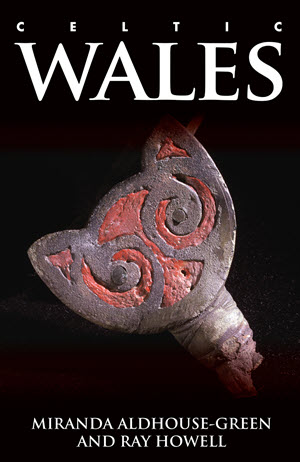Celtic Wales
 Those of you who read books about the ancient history of British Isles are probably already familiar with the name, Miranda Green. These days she is Miranda Aldhouse-Green and Professor Emerita in Archaeology at Cardiff University. Ray Howell is less well known on the popular history circuit, but he is a retired professor of Welsh Antiquity at the University of Wales. These are, in other words, two academic heavy hitters.
Those of you who read books about the ancient history of British Isles are probably already familiar with the name, Miranda Green. These days she is Miranda Aldhouse-Green and Professor Emerita in Archaeology at Cardiff University. Ray Howell is less well known on the popular history circuit, but he is a retired professor of Welsh Antiquity at the University of Wales. These are, in other words, two academic heavy hitters.
So what, you might ask, are two retired senior academics doing writing a popular history book called Celtic Wales. It turns out that they felt compelled to say something on what is now known as the ‘Celtic Debate’. That in turn appears to be partly a result of attempts by right-wing English historians to re-frame the history of Prydain (Britain) as the history of the English, and to effectively erase Welsh, Scottish and Irish cultures. Things have got a lot worse since the book was originally published. The Prime Minister, Mr. Sunak, appears to believe that using Welsh names for places in Wales is “woke”, and therefore something up with which he will not put.
One of the reasons why we are in this mess is because ‘Celtic’ means many different things. Aldhouse-Green and Howell, having spent much of their academic lives on the issue, are well placed to explain the nuances. Here are some of the questions in play.
To start with there are ancient authors who refer to people they call Celtae (in Latin), or Keltoi (in Greek). These authors include Aristotle and Julius Caesar. So we can be reasonably sure that there were people that they called Celts. But given that they were writing hundreds of years apart, about people from opposite ends of Europe, we can’t be sure that they meant the same people. Significantly from our point of view, Caesar did not call the people of these isles Celts, he called them Britons.
Next up there is Celtic as an art form. Archaeological finds from across Northern Europe show a certain similarity of artistic style. These may hint at a common culture, but they don’t necessarily imply common ethnicity. After all, just because someone in Chicago reads manga and has a collection of Sailor Moon dolls, that doesn’t mean that she’s Japanese. Nor does it mean that someone from Mumbai who speaks English and is passionate about cricket is ethnically English. Culture travels much faster then populations.
The most significant piece of data is Celtic language. There are two main Celtic language groups, each of which contains several languages that are very similar. Brythonic languages include Welsh, Cornish and Breton. Goidelic languages include Scottish Gaelic, Irish and Manx. And the two groups seem to have evolved from a common core. However, these languages were mostly not written down until mediaeval times. We know that they are very ancient languages, but we can’t prove that they were ever widely spoken in Iron Age Europe.
Unfortunately we also have the clumsy speculation of early archaeologists, and the fabrications of the likes of Iolo Morganwg. Much of what popular culture sees as ‘Celtic’ is still derived from historical speculation that was at best sloppy, and at worst dishonest.
All of which has given rise to ‘Celtic’ culture in places like the USA and Australia where drinking green Guinness on St. Patrick’s Day seems to be regarded as an ancient ethnic tradition. This sort of thing makes academic archaeologists tear their hair out in despair.
So, beset by attempts to claim that ‘Celtic’ culture never existed, and that any claim to cultural distinctiveness outside of English Britishness is simply bad history, Aldhouse-Green and Howell have attempted to chart a middle course and explain what archaeologists actually know about the ancient history of Wales. The result is a short and remarkably informative book. It is well worth a read if you are interested in such issues. And it does touch on both religion and mythology, in case you were wondering.
Of course being somewhat familiar with the period in question, I do notice things that the casual reader would not. The attitudes that the authors have towards the gender and sexual diversity seem to be more rooted in the 19th and 20th centuries than modern scholarship. But you have to know what you are looking for to notice that so I’m not going to complain. And once I get a car again I will be looking forward to visiting museums and archaeological sites around the country to see some of the things this book talks about.

Title: Celtic Wales
By: Miranda Aldhouse-Green & Ray Howell
Publisher: University of Wales Press
Purchase links:
Amazon UK
Amazon US
Bookshop.org UK
See here for information about buying books though Salon Futura